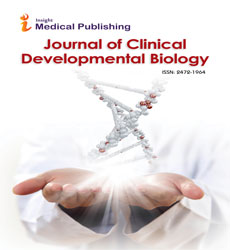Macroecapsulation of Pancreatic Progenitors: A New Era in Diabetes Therapy?
Gioia P. Polidori
Gioia P. Polidori*
Department of Biological Sciences, Dana and David Dornsife, College of Letters, Arts and Sciences, University of Southern California, Los Angeles, USA
- *Corresponding Author:
- Gioia P. Polidori
Lecturer, Human & Evolutionary Biology, Department of Biological Sciences
Dana and David Dornsife, College of Letters, Arts and Sciences, University of Southern California, Los Angeles, USA
Tel: 213-740-3337
E-mail: gpolidor@usc.edu
Received date: December 17, 2015; Accepted date: December 24, 2015; Published date: December 29, 2015
Editorial
The pioneering work on islet transplantation led by Dr. Ray Rajotte marked the beginning of an era: the Edmonton protocol. Between 2000 and 2012 approximately 750 successful islet transplantations have been performed worldwide and the Edmonton group has now achieved a 70% eight-year graft survival rate [1]. However, this approach still has several limitations, including lack of longterm glycemic control and insulin independence, reliance on pancreas donors, transplant rejection/immune response and long-term risks of immunosuppressive therapy. ViaCyte, Inc., a privately held regenerative medicine company based in San Diego, is now beginning a clinical trial that could possibly obviate all these concerns. ViaCyte is using a universal cell therapy approach based on transplantation and retention of encapsulated insulin producing cells [2].
ViaCyte is using human Embryonic Stem Cells (hESC) as a source of a pancreatic endoderm lineage, PEC-01, which is 73- 80% PDX-1+/NKX6.1+ [3]. This cell population can be produced on a large scale and differentiated toward glucose-responsive insulin-secreting cells and other pancreatic endocrine cells upon engraftment. Most importantly, PEC-01 cells retain their identity and functionality after cryopreservation [2], capability that is fundamental for the establishment of efficient clinical applications. Additionally, compared to induced pluripotent stem cells, hESCs could be a more suitable source of progenitor cells for regenerative purposes because of their genomic stability and increased immune tolerance [4,5].
One of the major limitations of regenerative medicine is the difficulty in maintaining graft functionality in spite of immune rejection. Compelling evidence shows that encapsulation of the transplanted cells may obviate such immune rejection [3,6]. Encapsulation may also provide means to readily isolate the transplanted cells in the undesirable case of tumor development. Considering the intrinsic heterogeneous nature of stem cells, transplanted cells may still retain substantial proliferative potential and in fact it was already reported that, even after enrichment, 1-3% of the transplanted cells are still progenitors [3]. This is an issue that needs careful consideration as progenitors may contribute to the tumorigenic potential of the transplanted cells. Yet, encapsulation of cells in a bilaminar device (TheraCyte Inc.) was already demonstrated to prevent cell escape [7]. Additionally, in the unlikely event of cell escape, it is plausible to speculate that a competent immune system would be able to detect and neutralize such cell. Taken together, these findings demonstrate the importance of encapsulating cells for transplantation. ViaCyte has developed a planar macroencapsulation device consiting of a semipermeable barrier that can be loaded with PEC-01 cells and implanted subcutaneously: the Encaptra drug delivery system. This approach was shown to retain robust function for at least 6 months following transplantation [2].
Although the published findings seem particularly promising, several concerns remain to be addressed. One important issue could be the potential permeability to humoral components of the immune system that could in turn elicit an immune response, contribute to fibrosis, and ultimately impair insulin release by causing necrosis of the transplant. One additional concern that would need to be addressed is the device size. In fact, it was estimated that this kind of planar devices in humans would require a length of 46 meters [8]! Lastly, long-term glycemic control and insulin independence still need to be evaluated.
ViaCyte has now initiated a phase I to II clinical trial transplanting PEC-01 cells in the Encaptra macroencapsulation device (ClinicalTrials.gov identifier NCT02239354). This is a remarkable achievement that seems to open the doors to a new era in diabetes therapy.
References
- McCall M, Shapiro AMJ (2012) Update on islet transplantation. Cold Spring Harbor perspectives in medicine 2: 007823.
- Schulz TC, Young HY, Agulnick AD, Babin MJ, Baetge EE, Bang AG, et al. (2012) A scalable system for production of functional pancreatic progenitors from human embryonic stem cells. PloSone 7: 37004.
- Agulnick AD, Ambruzs DM, Moorman MA, Bhoumik A, Cesario, et al. (2015) Insulin-Producing Endocrine Cells Differentiated In Vitro From Human Embryonic Stem CellsFunction in MacroencapsulationDevices In Vivo. Stem cells translational medicine 4: 1214.
- Zhao T, Zhang Z, Rong ZXu Y (2011) Immunogenicity of induced pluripotent stem cells. Nature 474: 212-215.
- Okano H, Nakamura M, Yoshida K, Okada Y, Tsuji O, et al. (2013) Steps Toward Safe Cell Therapy Using Induced Pluripotent Stem Cells. Circulation research 112: 523-533.
- Kumagai-Braesch M, Jacobson S, Mori H, Jia X, Takahashi T, (2013) TheTheraCyte™ deviceprotectsagainst islet allograft rejection in immunized hosts. Cell transplantation 22: 1137.
- Kirk K, Hao E, Lahmy R, Itkin-Ansari P (2014) Human embryonic stem cell derived islet progenitors mature inside an encapsulation device without evidence of increased biomass or cell escape. Stem cell research 12: 807-814.
- Tan G, Elefanty AG, Stanley EG (2014) cell regeneration and differentiation: how close are we to the 'holy grail'?. Journal of Molecular Endocrinology 53: 119-129.
Open Access Journals
- Aquaculture & Veterinary Science
- Chemistry & Chemical Sciences
- Clinical Sciences
- Engineering
- General Science
- Genetics & Molecular Biology
- Health Care & Nursing
- Immunology & Microbiology
- Materials Science
- Mathematics & Physics
- Medical Sciences
- Neurology & Psychiatry
- Oncology & Cancer Science
- Pharmaceutical Sciences
